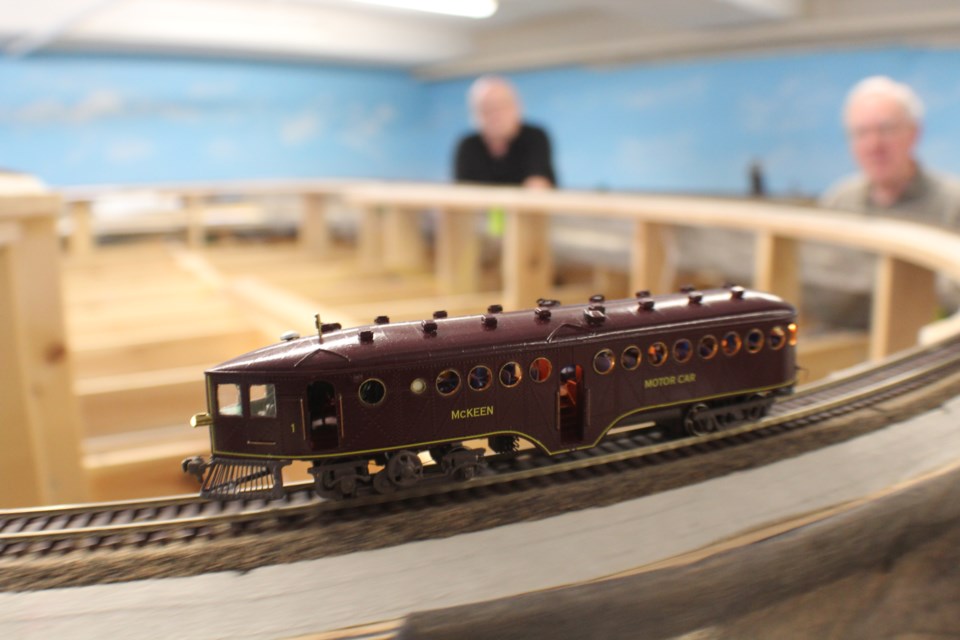Model trains come in all kinds of shapes and sizes and from different eras, just like the people who enjoy the hobby.
The Barrie Allandale Railway Modellers (BARM) will have a display at the downtown Barrie Public Library branch, located at 60 Worsley St., on Saturday, Dec. 29 from 9:30 a.m. until 5 p.m., and Sunday, Dec. 30 from noon until 4 p.m. The set-up at the library this weekend will cover an area of approximately six by 12 feet and will run three tracks.
“It’s more or less just an oval track and there will be a tunnel,” club president Dave Warnica tells BarrieToday during a visit to their Bradford Street clubhouse. “There are some buildings and a little town site and a couple of industries.
"Most people just like to see the trains run. People find it very entertaining and the families really enjoy it if they’re looking for something to do before the kids go back to school, so this is something they’ll get a kick out of.”
The Bradford Street clubhouse, which the group moved into in June 2017, has a massive set-up underway, which began that September. It’s expected to take two and a half years before it’s complete.
The club has been around for more than 50 years and currently has 20 members, hailing from Barrie, Bradford, Angus, Orillia, Sharon and Holland Landing. Most are retired guys, but there are also several younger people. Membership runs from around 20 years old up to people their mid-80s, with new members always welcome.
“We have one young fella who actually works for GO train,” Warnica says. “We also have a younger gentleman who’s a sergeant in the military at Borden and he also has a 10-year-old son, so that’s part of his interest. But if you can still stand at a hundred, you can still be part of the club.”
Warnica says the club will also take younger teenagers, but they have to be accompanied by an adult.
The vast age range is part of the draw.
“There’s a lot of teaching that goes on, passing along information to some of the younger guys,” Warnica says. “There’s quite a large community.”
While the club has been around for decades and plenty of valuable information has been shared, the advent of the internet has also allowed hobbyists to seek out people who may have the information they’re after.
“Usually you get a variety of options and a variety of opinions. Some of the advice is not that great, but most of it is very helpful,” he says.
Lately, that could be anything from the type of wood used for the club’s set-up to how to lay the track or how to wire a turn-out.
Many people who come into the hobby ran toy trains while they were kids.
“The train was the toy to have at Christmas for generations, starting in the ’30s when toy train sets became affordable to the public,” Warnica says. “There’s a lot of nostalgia in it, but for people in the hobby, it’s way more complex that that. There are so many different skills required to actually set up.”
A lot goes into the hobby before the trains even chug down the tracks.
“If you’re going to do something like this, you have to understand the electrical, first of all, and then you need to understand modelling skills to actually get the body to look the way it’s supposed to look,” says Warnica, who lives in Bradford. “You have to learn how to tune them to make sure they perform nicely and aren’t constantly derailing or stalling.”
Then there’s also the scenery aspect of a set-up and the finer points of the paint, which can be detailed right down to the colour of a boulder to the minuscule pinstripes, or even placing the decals.
Some club members, such as Warnica, are also into what’s called scratch building where he’ll start with a donor drive train and build the body around it, right down to the handmade roof vents.
“But my work is crude compared to some guys,” he says, using an example of a 1907 street car from the western United States, called a McKeen Motor Car.
He said it took about 50 hours to complete the piece, but the real satisfaction comes in seeing it dart down the track.
While there has been a resurgence in trains in recent years, such as bringing the GO line to Barrie, Warnica says everyone leans toward a certain time period.
“People in the hobby tend to have their own eras,” says Warnica, who prefers what’s referred to as the transition era, from steam to diesel. “That started in the late ’30s and basically steam was done by the mid ’50s.
"But lots of guys are right into the real modern stuff and there’s quite a few people who love the GO trains and that sort of commuter train, so that’s a big part of the market.”
There are also a variety of scales that model-train enthusiasts could be into, from N scale (1:160) to HO scale (1:87) on the smaller end, up to O scale or SN-3, which are much larger and allow for more detail, while the smaller scales can be “a little bit fussy.”
“If you’re going to have a bigger scale, you have to have more space,” Warnica says. “Or you have a very small switching layout where you just basically push the cars back and forth. Lots of guys that are into the really big scale, like G scale, they have garden railways, so they have a fair amount of real estate outside.
“But you don’t have to have a lot of space to enjoy it.”
The club’s flagship event, which includes vendors and various set-ups, happens Feb. 16-17 at Bradford Greenhouses Garden Gallery on County Road 90, just west of Barrie.
For more information on the club, visit www.barm.ca.



